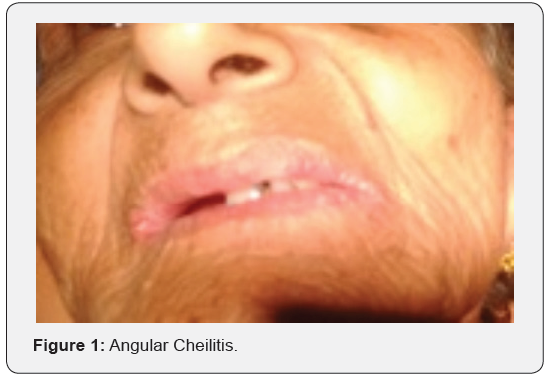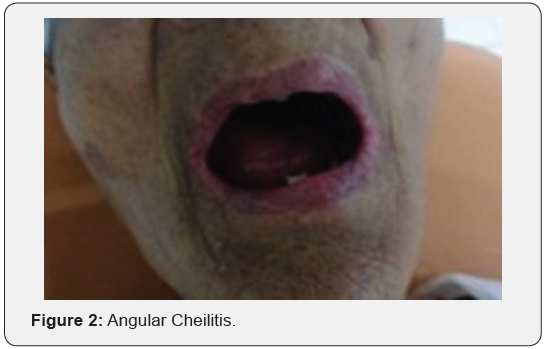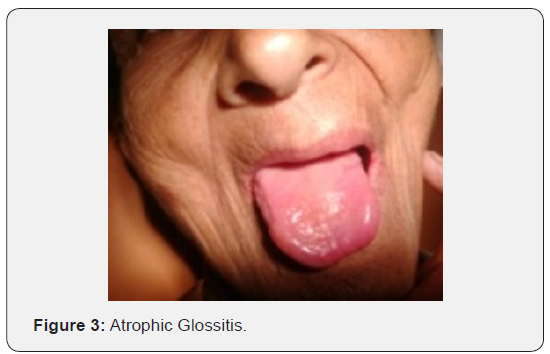Juniper Publishers- Open Access Journal of Case Studies
Diagnosis of Iron Deficiency Anemia through Oral Manifestation - A Case Report
Authored by Marzia Cottini
Abstract
Anemia is a major public health problem worldwide, particularly among women in developing countries. Oral mucosa reflects the general health status. The changes detected on the tongue and labial mucosa in anemia may in certain cases precede general systemic features. Dentists can play an important role in identification and thereby prevention of anemia, as oral manifestation may be the earliest feature of the condition. We report a case of diagnosis of Iron deficiency anemia through oral manifestation.
Introduction
Anemia is a major public health problem worldwide, particularly among women in developing countries. Dentists can play an important role in identification and thereby prevention of anemia as oral manifestation may be the earliest feature of the condition [1]. We report a case of diagnosis of Iron deficiency anemia through oral manifestation.
Case Report
A 68-year-old female patient presented to the department of oral medicine with a chief complaint of mobility of the lower left teeth for 3 months. There were no associated symptoms. She was conscious and cooperative, moderately built, poorly nourished. There were no peripheral signs of systemic disease. There was no abnormality detected on extra oral examination. On intraoral examination, there was erosion noticed at the corner/angle of the mouth (Figure 1 & 2). Depapillation on the dorsal surface of the tongue (bald tongue) (Figure 3), pallor and an area of erosion was noticeable on the buccal mucosa (Figure 4). All the teeth on the right side of the maxillary arch and left side of mandibular arch were missing. There was generalized mobility of remaining teeth. A diagnosis of chronic generalized periodontitis was made. Complete Blood Count was advised to check for anemia. Her Hb was 7.8g/dl, total and differential count were in normal limits. A diagnosis of iron deficiency anemia was made she was referred to general physician for further assessment. She was given oral ferrous sulphate therapy, to which she responded positively. Following this dental treatment was provided.




Discussion
Anemia is a widely prevalent condition. According to WHO it is a condition in which the Haemoglobin (Hb) content of blood is lower than normal as a result of deficiency of one or more essential nutrients. Globally, anaemia affects 1.62 billion people, which corresponds to 24.8% of the population. The highest prevalence is in preschool-age children (47.4%), and the lowest prevalence is in men (12.7%) [2,3]. Prevalence of anemia in the elderly has been found to be around 8 -44%, with a higher prevalence in men above 85 years of age.
Identifying anemia is important as it is debilitating and induces or worsens congestive heart failure, causes cognitive impairment, dizziness and apathy. Anemia in the older adult has been reported to have reached crisis levels as anemia is associated with changes in the quality of life, decreased cognition and functional ability, and an increased risk for falls, infections, morbidity, and mortality [4,5].
Hemoglobin concentration is a widely used measure of anemia, although serum ferritin levels are considered a more sensitive marker. A strong correlation exists between Hemoglobin and serum ferritin levels. Hemoglobin levels are easier to measure and also useful in monitoring the effectiveness of intervention [6]. Hence this parameter alone is sensitive in detecting anemia. Severity of anemia is classified as
a) Mild (10-10.9 g/dl for pregnant women,10- 11.9g/dl for non-pregnant)
b) Moderate (7-9.9g/dl) and
c) Severe (<7g/dl) based on Hb concentration in women [1,6].
Iron deficiency is one of the main etiologic factors for anemia [1,3]. The main cause of this being Low dietary intake like iron, folic acid and vitamin B12, and other factors being chronic diseases and chronic blood loss due to hookworm infestation and malaria [2].
The oral signs and symptoms of anemia are well recognized and easily detectable. They are glossitis, glossodynia, angular cheilitis, recurrent oral ulcer, oral candidiasis, erythematous mucositis, and palor of oral mucosa. In some patients as in this case the initial manifestation of anemia of chronic diseases may present in the oral cavity before general symptoms develop [7,8].
The oral changes occur as a result of basic changes in the metabolism of oral epithelial cells. These changes give rise to abnormalities in cell structure and the keratinization pattern of the oral epithelium. On the dorsal surface of the tongue it leads to a “beefy” red and inflamed i.e., erythematous macular lesions because of marked epithelial atrophy and reduced thickness of the epithelial layer [9].
The general signs and symptoms of anemia such as pallor, fatigue and dyspnea may be overlooked in elderly as these findings may be attributed to old age [4]. The oral signs and symptoms offers the dentist an opportunity to participate in the diagnosis of this condition.
Conclusion
According to the WHO reports screening for anemia, treatment of anemic women, and availability and use of nutrient supplements are the key to reduce anemia in adolescent and pregnant women. Oral mucosa reflects the general health status. The changes detected on the tongue and labial mucosa in anemia may in certain cases precede general systemic features. An astute dentist will be able to identify these clinical features and help in screening and early diagnosis and treatment by prompt referral to the physician.
For more articles in Open Access Journal of Case Studies please click on: https://juniperpublishers.com/jojcs/index.php



No comments:
Post a Comment